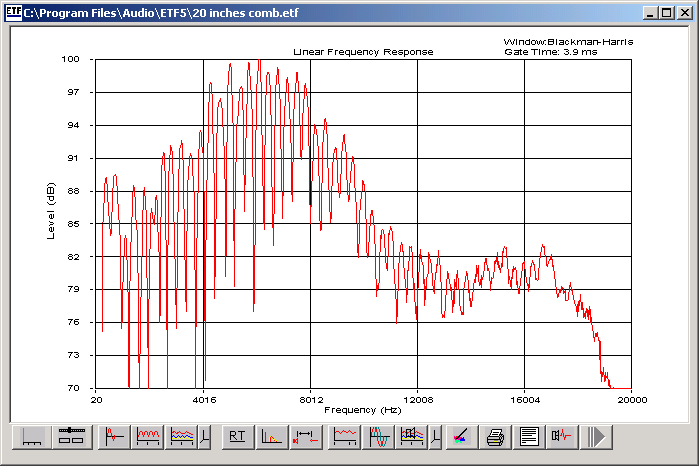David,
What exactly is comb filtering?
Comb filtering is a specific type of frequency response error that's characterized by a series of many peaks and deep nulls. It's almost always caused by acoustic reflections, but it can also be created electronically using a delay. This graph shows comb filtering:
The graph above is from this article on our web site:
http://www.realtraps.com/art_spaces.htm
There's also a video on our site that let's you hear what it sounds like here:
http://www.realtraps.com/videos.htm
Why would absorbing a long bass wave reduct it? What happens to the shorter waves and would why would they not contribute to comb filtering?
All waves can create comb filtering. Comb filtering occurs whenever you combine a source signal with a delayed version of the same signal. Depending on the delay time, some frequencies are combined in phase (peaks) and some are out of phase (nulls).
Also, my general understanding of applying room treatments is to treat all corners with your mini or mondo trap products. Then to listen the room with less muddied bass and place additional products based on experience. Is this correct?
It's even simpler than that. My approach is as much bass trapping as possible, plus absorption at the first reflection points. If the wall behind you is very close by, additional absorption on that wall is needed to avoid comb filtering. If the wall is 3 to 5 feet or more behind you, then diffusion is a good alternative to absorption. But what you choose behind you is about the only "season to taste" aspect as I see it.
Martin Logan speakers have a very small sweet spot ... How realistically can this sweet spot be increased with effective room treatments or should this limitation be accepted?
Adding first reflection absorption will
absolutely increase the physical size of the area where the response is more or less flat. Which is how I'd define a sweet spot.
What is your take on Charlie Hansen's comment that most products do not absorb below 100 Hz, which seems to be the reason he lost faith in them.
As I read his post his experiments were a long time ago. Our bass traps are effective to much lower frequencies than 100 Hz, and with enough of them (8 or more) I've measured an improvement to as low as 30 Hz. Yes, I've seen plenty of really expensive "acoustically treated" rooms that sounded terrible. The problem is not the presence of acoustic treatment, but rather an improper use of it. For example, a lot of people use too-thin foam or fiberglass panels all over their room. So the room is too dead, yet boomy at the same time. Sadly, and maybe not surprisingly, how much something costs seems to have little relation to how good it is.

What is your take on Cardas ratio of speaker placement, taking room treatments into account?
There are a lot of opinions on this stuff, and I admit I have not tried them all. But I think it's too simplistic to expect
any "one size fits all" philosophy to work in all rooms. My approach is described in this Room Setup article on our site:
http://www.realtraps.com/art_room-setup.htm
This method identifies the ideal listener placement first, then uses actual measurement (when possible) to find the best places for the speakers. Understand that measuring the low frequency response at high resolution is the
only way to know which placements are best. There are too many variables to be able to predict what happens in a small room. For example, if the walls are thick sheet rock, or thin sheet rock, or the space inside the wall is insulated or not insulated, and the proximity of furniture, and what the furniture is made from - all of these have a direct impact on the bass response you'll actually get.
--Ethan




